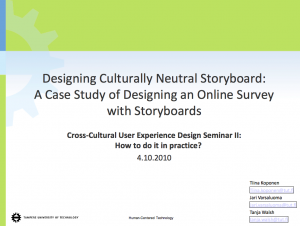MediaIndigena is a content aggregate blog (or, an “interactive media magazine”) that I have found useful throughout the past 13 weeks for keeping an ear to the ground on the myriad of topics that have been brought up through our discussions and readings. The site is authored by ten individuals with very different backgrounds and professions (of which you can read about by clicking their names), sort of like the ETEC521 research blog but hopefully not about to culminate it’s posting cycle! If you’re interested in keeping up with MediaIndigena, they’re also available via twitter and facebook, and, following those links you’re sure to snowball to other such blogs, websites, and organizations.
Tag Archives: Social Networking
Culturally Neutral Technology?
In Module 1, we’ve examined whether or not technology is culturally neutral. Our readings and interactions thus far have indicated it is not. I have discovered online a case study by the Tampere University of Technology which examines the design of an online survey using what is described as a “culturally neutral storyboard.” Many of the questions related to social networking services. While not explicitly related to aboriginal education, I thought this tied in nicely with our module one discussion on the cultural neutrality of technology, particularly since it was using storyboards as a vehicle. Aboriginal history, being based on an oral tradition, I believe can likely identify more with storyboarding as their history is, indeed, based on a series of stories. It was interesting to note in this study the different reactions different cultural groups would give to certain storyboard images. For example, Indian respondents interpreted a bunch of friends on a beach to be a family gathering, whereas other cultural groups may interpret the gathering differently. The results of the study identified a few main findings, including the fact that storyboards helped respondents to understand difficult concept ideas and imagine themselves into the use situations, which made answering to the social networking services questions easier and fun. In addition, the storyboards themselves were well understood by users with different cultural backgrounds. The case study presentation can be found online here.
